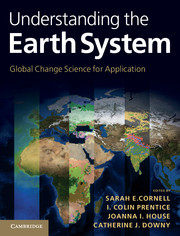Book contents
- Frontmatter
- Contents
- Editors
- Scientific editorial team members
- Contributing authors
- Foreword
- Preface
- Acknowledgements
- Units
- 1 Earth system science and society
- 2 Fundamentals of climate change science
- 3 How has climate responded to natural perturbations?
- 4 The Earth system feedbacks that matter for contemporary climate
- 5 Earth system models
- 6 Climate change impacts and adaptation
- 7 The role of the land biosphere in climate change mitigation
- 8 Society’s responses and knowledge gaps
- Acronyms
- Glossary of terms
- Index
- References
2 - Fundamentals of climate change science
Published online by Cambridge University Press: 05 November 2012
- Frontmatter
- Contents
- Editors
- Scientific editorial team members
- Contributing authors
- Foreword
- Preface
- Acknowledgements
- Units
- 1 Earth system science and society
- 2 Fundamentals of climate change science
- 3 How has climate responded to natural perturbations?
- 4 The Earth system feedbacks that matter for contemporary climate
- 5 Earth system models
- 6 Climate change impacts and adaptation
- 7 The role of the land biosphere in climate change mitigation
- 8 Society’s responses and knowledge gaps
- Acronyms
- Glossary of terms
- Index
- References
Summary
This chapter provides a high-level summary of the state of knowledge regarding observations, processes and models of climate, terrestrial ecosystems and the global carbon cycle. We focus strongly on observations (at various timescales, including palaeo timescales as appropriate), and what can be learned from their interpretation in the light of the established principles of climate science and terrestrial ecosystem science. The field is very broad and therefore we have had to be highly selective. We discuss aspects pertinent to understanding recent and contemporary changes in climate and the global carbon cycle, with emphasis on the terrestrial component.
Observing and studying climate
Background and history of climate science
Like the weather, everyone has an interest in climate and knows something about it. Climate is generally understood as ‘average weather’. By definition, climate cannot change from year to year; but it can (and does) change over decades and centuries.
Until the 1970s, the study of climate was largely descriptive. The data were concentrated in certain regions, and often anecdotal. Nonetheless, as Lamb (1982) and others described, these data already showed the existence of a great deal of variability in climate on many timescales, and that this variability has had a pervasive impact on human societies.
Climate also has a dominant effect on ecosystems. The patterns of terrestrial biomes, from dense tropical forests to high-latitude and mountain tundra and deserts, reflect spatial patterns of average temperature and rainfall and show that climate has had a profound role in shaping the ecology and evolution of land plants. Relationships between vegetation and climate formed the basis for Köppen’s (1918) classification of world climates, which allowed climate to be inferred from vegetation at a time when direct climate observations were sparse.
Information
- Type
- Chapter
- Information
- Understanding the Earth SystemGlobal Change Science for Application, pp. 39 - 71Publisher: Cambridge University PressPrint publication year: 2012
References
Accessibility standard: Unknown
Why this information is here
This section outlines the accessibility features of this content - including support for screen readers, full keyboard navigation and high-contrast display options. This may not be relevant for you.Accessibility Information
- 5
- Cited by
